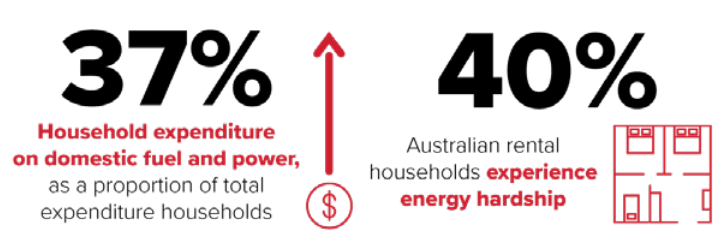
Many Australian households who rent their housing experience energy hardship
Minimum standards for energy performance of rental homes will help those facing energy hardship
05 Oct 2020
It is estimated that up to 40 per cent of Australian households who rent their housing may be experiencing energy hardship, due to a meeting of rapidly rising energy costs, a large stock of poor-quality and energy-inefficient dwellings in the rental sector, uneven access to efficient technologies and government interventions, and a large number of households in financial hardship. Household expenditure on domestic fuel and power, as a proportion of total expenditure, rose in the period 2009–10 to 2015–16 by up to 37 per cent. The community, governments and the property sector are looking for guidance on which strategies or approaches can work to improve energy affordability and efficiency of dwellings in the rental sector.

New AHURI research, ‘Warm, cool and energy affordable housing policy solutions for low-income renters’, undertaken for AHURI by researchers from the University of Adelaide, RMIT University and the University of South Australia examines the full impacts of energy hardship in Australia’s rental housing market and considered strategies and policy actions to reduce its effect on lower income households.
The research examined surveys of low-income renters that found there are numerous housing quality issues affecting low-income households renting in both private and social housing. Indeed, 18 per cent of public renters and 14 per cent of private renters were unable to keep sufficiently warm in winter.
‘It is critical that we’re able to capture and then monitor the different factors that lead people into energy hardship overtime so that effective policy responses that catch people before they experience deep and long-term disadvantage can be developed.’
Tenants were constrained with what they could do reduce heating and cooling their homes and felt that landlords didn’t see property upgrades that made dwellings cheaper to heat or cool as being smart investment decisions. While landlords were reported to be amenable to tenants spending their own money on these projects, tenants were not enthusiastic about investing in their rented properties given the insecurity of their tenure.
‘One of the big problems is that there is no agreed definition of how the community measures energy hardship’ says lead research Dr Lyrian Daniel from the University of Adelaide. ‘It is critical that we’re able to capture and then monitor the different factors that lead people into energy hardship overtime so that effective policy responses that catch people before they experience deep and long-term disadvantage can be developed.’
The research found that minimum standards for the energy-performance of rental homes is a critical starting point to improving living conditions and energy affordability within the rental sector and must underpin all other strategies. There needs to be a clear understanding of what constitutes basic housing quality. This could be partially addressed by creating and enforcing minimum energy-efficiency standards.
‘...landlords could be ‘incentivised’ to improve their houses’ energy efficiency and performance over time’ says Dr Daniel. ‘This could be done through claim(ing) tax rebates or other financial assistance so that appliances, such as old, inefficient hot-water services, could be upgraded to more energy efficient models instead of replaced with ‘like-for-like’.’
In addition, mandatory disclosure of dwelling performance was seen as a potentially powerful tool to aid residents in their selection of properties, and as a way of monitoring compliance with minimum standards. The research noted, however, that installing heaters or air conditioners to make housing more comfortable may simply mean lower income tenants are unable to afford to operate the appliances, leaving their home either too hot or too cold.
‘One strategy we propose is that landlords could be ‘incentivised’ to improve their houses’ energy efficiency and performance over time’ says Dr Daniel. ‘This could be done through landlords being able to claim tax rebates or other financial assistance so that appliances, such as old, inefficient hot-water services, could be upgraded to more energy efficient models instead of replaced with ‘like-for-like’.’
The research identified health impacts as one of the most powerful discourses available to motivate policy response to these problems. ‘Bringing together government and non-government experts, we reached a consensus that policy objectives that support tenants’ health and wellbeing must the primary guiding objective,’ says Dr Daniel. ‘A clear definition of what constitutes a ‘decent’ or ‘safe’ home—currently lacking in Australia—must be developed to support these objectives.’
On 15 October 2020, AHURI will host a Research Webinar, Energy-affordable housing policy solutions, with Dr Lyrian Daniel. This webinar will examine the correlation between exposure to energy hardships and living in dwellings that are in poor condition, identify solutions to improve energy affordability and dwelling energy efficiency in Australia’s rental sectors and discuss the portfolio of policies or governmental actions that will be needed to meet the challenge of improving energy efficiency in the rental housing stock.
The report can be downloaded from the AHURI website at http://www.ahuri.edu.au/research/final-reports/338
